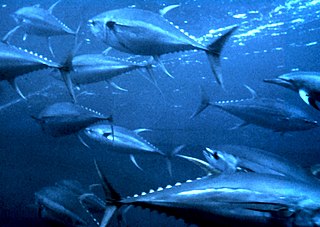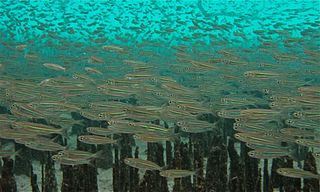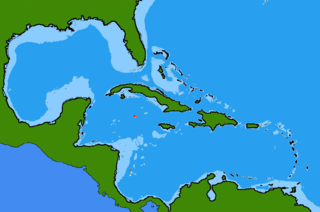
A tuna is a saltwater fish that belongs to the tribe Thunnini, a subgrouping of the Scombridae (mackerel) family. The Thunnini comprise 15 species across five genera, the sizes of which vary greatly, ranging from the bullet tuna up to the Atlantic bluefin tuna, which averages 2 m (6.6 ft) and is believed to live up to 50 years.

Mackerel is a common name applied to a number of different species of pelagic fish, mostly from the family Scombridae. They are found in both temperate and tropical seas, mostly living along the coast or offshore in the oceanic environment.

Herring are various species of forage fish, belonging to the order Clupeiformes.

Sardine and pilchard are common names for various species of small, oily forage fish in the herring suborder Clupeoidei. The term 'sardine' was first used in English during the early 15th century; a somewhat dubious etymology says it comes from the Italian island of Sardinia, around which sardines were once supposedly abundant.

Sprat is the common name applied to a group of forage fish belonging to the genus Sprattus in the family Clupeidae. The term also is applied to a number of other small sprat-like forage fish. Like most forage fishes, sprats are highly active, small, oily fish. They travel in large schools with other fish and swim continuously throughout the day.

Thunnus is a genus of ocean-dwelling, ray-finned bony fish from the mackerel family, Scombridae. More specifically, Thunnus is one of five genera which make up the tribe Thunnini – a tribe that is collectively known as the tunas. Also called the true tunas or real tunas, Thunnus consists of eight species of tuna, divided into two subgenera.

The lined silverside is a species of fish in the family Atherinidae. It is found in Indonesia and the Philippines. This species was described as Atherina lineata by Albert Günther in 1872 with the type locality given as Cebu.
The Kokoda mogurnda is a species of fish in the family Eleotridae endemic to Papua New Guinea, where it is an inhabitant of clear streams in the rainforest. This species can reach a length of 8.5 cm (3.3 in).

An anchovy is a small, common forage fish of the family Engraulidae. Most species are found in marine waters, but several will enter brackish water, and some in South America are restricted to fresh water.

Starksia y-lineata, the forked bar blenny, is a species of labrisomid blenny native to reef environments of the Caribbean Sea. This species can reach a length of 1.9 cm (0.75 in) SL.
Metzia is a genus of freshwater ray-finned fish belonging to the family Xenocyprididae, the East Asian minnows or sharpbellies. The fishes in this genus are found in Asia. The genus is named in honor of the American ichthyologist Charles William Metz of Stanford University.

Parahollardia is a genus of marine ray-finned fishes belonging to the family Triacanthodidae, the spikefishes. These demersal fishes are found in the Western Atlantic Ocean.

Caesio varilineata, the variable-lined fusilier or thin-lined fusilier, is a species of pelagic marine ray-finned fish, a fusilier belonging to the family Caesionidae. It is found in the Indo-Pacific region.
Metzia alba is a species of freshwater ray-finned fish belonging to the family Xenocyprididae, the East Asian minnows or sharpbellies. This species is endemic to Viet Nam.
Metzia formosae is a species of freshwater ray-finned fish belonging to the family Xenocyprididae, the East Asian minnows or sharpbellies. It is considered "least concern" by the IUCN Red List. It inhabits small rivers in still or slow-moving waters and can be found in Yunnan, China and Taiwan. The mitogenome of Metzia formosae measures 16,614 base pairs, comprising 13 genes responsible for coding proteins, 22 transfer RNA genes, 2 ribosomal RNA genes, and a noncoding control region.
Metzia hautus is a species of freshwater ray-finned fish belonging to the family Xenocyprididae, the East Asian minnows or sharpbellies. This fish is only known from the Cả River in Viet Nam.
Metzia longinasus is a species of freshwater ray-finned fish belonging to the family Xenocyprididae, the East Asian minnows or sharpbellies. This species is found in the Hongshui-He River in Guangxi.

Nipponocypris sieboldii is a species of freshwater ray-finned fish belonging to the family Xenocyprididae, the East Asian minnows or sharpbellies. that is endemic to Japan. It has a maximum length of 12.5 centimetres (4.9 in).












